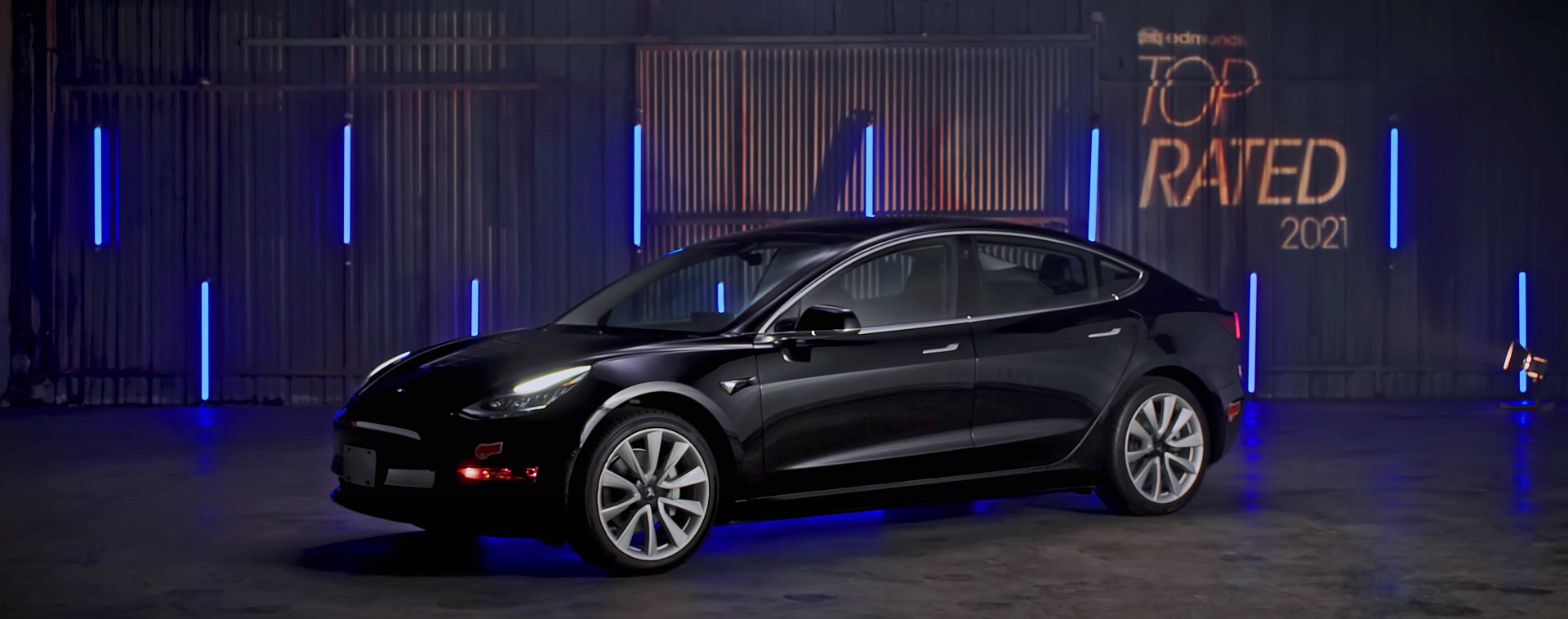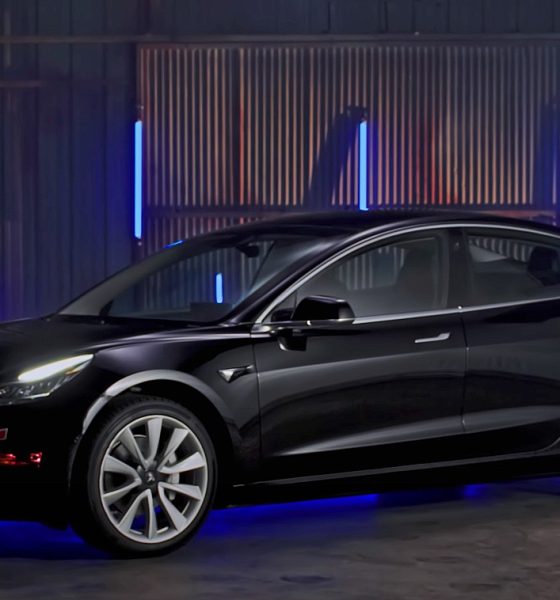The Tesla Model 3 has claimed Edmund’s Top Rated 2021 award for Best Electric Vehicle. It marks the second-consecutive year the all-electric sedan has claimed the honor of being the best EV on the market.
Edmunds announced that the Model 3 had won the award on December 16th, stating that Tesla’s most-affordable car had once again impressed the team and had proven itself as the best electric car available to consumers.
“More EVs have come out for 2021, yet no other manufacturer to date has been able to match the all-around excellence of the Tesla Model 3,” Edmunds wrote about Tesla’s most affordable vehicle.
Edmunds Top Rated 2021 award for Best EV for the second year in a row: @Tesla Model 3 https://t.co/z2kq02z2NA pic.twitter.com/j8poQMe2Om
— Edmunds (@edmunds) December 16, 2020
Paired with affordable pricing points, the Model 3’s big claim to fame in Edmunds’ perspective is its performance specifications. It’s instant torque from the all-electric powertrain, combined with “nimble handling and impressive practicality,” is enough to win over consumers, and it has. The Model 3 has been Tesla’s most popular car since its initial release in 2017. In 2020, three years later, it has continued this trend and has been the automaker’s claim to fame in an ever-changing automotive market. Tesla even “refreshed” the car this year, adding a more efficient heat pump and refining some of the interior features.
Additionally, the sedan’s cosmetic features have revolutionized the overall appeal of what is accepted in the industry. A minimalistic interior, void of the typical knobs and buttons that traditional car interiors are consumed by, is dominated by the large, centrally-located touchscreen, which houses GPS capabilities, and what seems like an endless number of infotainment features.
Tesla’s clean exterior and minimalist interior are now preferred by luxury buyers
But, as the old saying goes, “beauty lies in the eye of the beholder.” Even if someone did not like the look of the Model 3, they certainly couldn’t ignore the highly-attractive range ratings and widely-available Supercharging network that Tesla offers owners. Tesla’s introductory Model 3 variant offers 263 miles of driving capability on a single charge. In comparison, the Long Range configuration gives owners 353 miles of traveling after plugging in until the battery pack reaches its 100% capacity. Where many EV makers fall short is in the focus of range. Performance is important, but with charging points hard to come by with other manufacturers, Tesla holds a significant advantage as the company offers over 20,000 Supercharging locations globally.
Perhaps the most impressive feat of the Model 3 thus far is its ability to fend off a quickly-growing EV market that established automakers are just now entering. While there is no indication of whether the Model 3 will hold the top spot in 2021 because of more competition heading into the market, Tesla’s tech advantage and access to extremely convenient Over-the-Air updates give some indication that the three-peat is certainly within reach.
“In the next couple of years, we’ll see more and more competition from big-name brands such as Volkswagen, but for now at least, the Tesla Model 3 remains unbeatable,” Edmunds said.
Edmunds’ full list of 2021 Top Rated Award Winners is available here.

News
Tesla starts showing how FSD will change lives in Europe
Local officials tested the system on narrow country roads and were impressed by FSD’s smooth, human-like driving, with some calling the service a game-changer for everyday life in areas that are far from urban centers.

Tesla has launched Europe’s first public shuttle service using Full Self-Driving (Supervised) in the rural Eifelkreis Bitburg-Prüm region of Germany, demonstrating how the technology can restore independence and mobility for people who struggle with limited transport options.
Local officials tested the system on narrow country roads and were impressed by FSD’s smooth, human-like driving, with some calling the service a game-changer for everyday life in areas that are far from urban centers.
Officials see real impact on rural residents
Arzfeld Mayor Johannes Kuhl and District Administrator Andreas Kruppert personally tested the Tesla shuttle service. This allowed them to see just how well FSD navigated winding lanes and rural roads confidently. Kruppert said, “Autonomous driving sounds like science fiction to many, but we simply see here that it works totally well in rural regions too.” Kuhl, for his part, also noted that FSD “feels like a very experienced driver.”
The pilot complements the area’s “Citizen Bus” program, which provides on-demand rides for elderly residents who can no longer drive themselves. Tesla Europe shared a video of a demonstration of the service, highlighting how FSD gives people their freedom back, even in places where public transport is not as prevalent.
What the Ministry for Economic Affairs and Transport says
Rhineland-Palatinate’s Minister Daniela Schmitt supported the project, praising the collaboration that made this “first of its kind in Europe” possible. As per the ministry, the rural rollout for the service shows FSD’s potential beyond major cities, and it delivers tangible benefits like grocery runs, doctor visits, and social connections for isolated residents.
“Reliable and flexible mobility is especially vital in rural areas. With the launch of a shuttle service using self-driving vehicles (FSD supervised) by Tesla in the Eifelkreis Bitburg-Prüm, an innovative pilot project is now getting underway that complements local community bus services. It is the first project of its kind in Europe.
“The result is a real gain for rural mobility: greater accessibility, more flexibility and tangible benefits for everyday life. A strong signal for innovation, cooperation and future-oriented mobility beyond urban centers,” the ministry wrote in a LinkedIn post.
News
Tesla China quietly posts Robotaxi-related job listing
Tesla China is currently seeking a Low Voltage Electrical Engineer to work on circuit board design for the company’s autonomous vehicles.

Tesla has posted a new job listing in Shanghai explicitly tied to its Robotaxi program, fueling speculation that the company is preparing to launch its dedicated autonomous ride-hailing service in China.
As noted in the listing, Tesla China is currently seeking a Low Voltage Electrical Engineer to work on circuit board design for the company’s autonomous vehicles.
Robotaxi-specific role
The listing, which was shared on social media platform X by industry watcher @tslaming, suggested that Tesla China is looking to fill the role urgently. The job listing itself specifically mentions that the person hired for the role will be working on the Low Voltage Hardware team, which would design the circuit boards that would serve as the nervous system of the Robotaxi.
Key tasks for the role, as indicated in the job listing, include collaboration with PCB layout, firmware, mechanical, program management, and validation teams, among other responsibilities. The role is based in Shanghai.
China Robotaxi launch
China represents a massive potential market for robotaxis, with its dense urban centers and supportive policies in select cities. Tesla has limited permission to roll out FSD in the country, though despite this, its vehicles have been hailed as among the best in the market when it comes to autonomous features. So far, at least, it appears that China supports Tesla’s FSD and Robotaxi rollout.
This was hinted at in November, when Tesla brought the Cybercab to the 8th China International Import Expo (CIIE) in Shanghai, marking the first time that the autonomous two-seater was brought to the Asia-Pacific region. The vehicle, despite not having a release date in China, received a significant amount of interest among the event’s attendees.
Elon Musk
Elon Musk and Tesla AI Director share insights after empty driver seat Robotaxi rides
The executives’ unoccupied tests hint at the rapid progress of Tesla’s unsupervised Robotaxi efforts.

Tesla CEO Elon Musk and AI Director Ashok Elluswamy celebrated Christmas Eve by sharing personal experiences with Robotaxi vehicles that had no safety monitor or occupant in the driver’s seat. Musk described the system’s “perfect driving” around Austin, while Elluswamy posted video from the back seat, calling it “an amazing experience.”
The executives’ unoccupied tests hint at the rapid progress of Tesla’s unsupervised Robotaxi efforts.
Elon and Ashok’s firsthand Robotaxi insights
Prior to Musk and the Tesla AI Director’s posts, sightings of unmanned Teslas navigating public roads were widely shared on social media. One such vehicle was spotted in Austin, Texas, which Elon Musk acknowleged by stating that “Testing is underway with no occupants in the car.”
Based on his Christmas Eve post, Musk seemed to have tested an unmanned Tesla himself. “A Tesla with no safety monitor in the car and me sitting in the passenger seat took me all around Austin on Sunday with perfect driving,” Musk wrote in his post.
Elluswamy responded with a 2-minute video showing himself in the rear of an unmanned Tesla. The video featured the vehicle’s empty front seats, as well as its smooth handling through real-world traffic. He captioned his video with the words, “It’s an amazing experience!”
Towards Unsupervised operations
During an xAI Hackathon earlier this month, Elon Musk mentioned that Tesla owed be removing Safety Monitors from its Robotaxis in Austin in just three weeks. “Unsupervised is pretty much solved at this point. So there will be Tesla Robotaxis operating in Austin with no one in them. Not even anyone in the passenger seat in about three weeks,” he said. Musk echoed similar estimates at the 2025 Annual Shareholder Meeting and the Q3 2025 earnings call.
Considering the insights that were posted Musk and Elluswamy, it does appear that Tesla is working hard towards operating its Robotaxis with no safety monitors. This is quite impressive considering that the service was launched just earlier this year.










